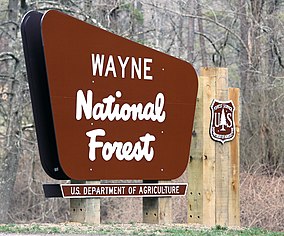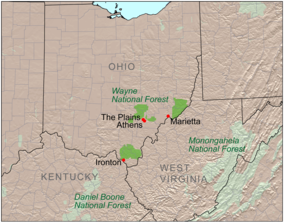| Wayne National Forest | |
|---|---|
 Welcome Sign for Wayne National Forest | |
 Location of Wayne National Forest | |
| Location | Ohio, United States |
| Coordinates | 39°30′0″N 82°0′0″W / 39.50000°N 82.00000°W |
| Area | 240,101 acres (971.65 km2)[1] |
| Established | December 1992[2] |
| Named for | Anthony Wayne |
| Website | Wayne National Forest |
The Wayne National Forest is located in the Appalachian part of the US state of Ohio, in the Unglaciated Allegheny Plateau. It is the first and only national forest in Ohio. Forest headquarters are located between The Plains and Nelsonville, Ohio, on US Route 33 overlooking the Hocking River.
First referred to as "Ohio National Forest" (unofficially),[3] the Wayne National Forest was later officially named in honor of General Anthony Wayne, an American soldier, officer, statesman, and one of the Founding Fathers of the United States. He served in the American Revolutionary War and was later recalled from civilian life by President George Washington after St. Clair's defeat to command the Legion of the United States in the Northwest Indian War to gain control of the British controlled ceded Northwest Territory, including the region that is now Ohio.[4]
The forest comprises three administrative and purchase units: Athens, Marietta, and Ironton. The Athens and Marietta Units are managed together as the Athens Ranger District, while the Ironton Unit is managed as the Ironton Ranger District. Many of the lands included in the national forest are former coal-mining lands, and much of this land is owned by the federal government without the mineral rights, those having been retained by former owners.
As of September 2018, Wayne National Forest has 244,265 acres (989 km2) in federal ownership within a proclamation boundary of 832,147 acres (3,368 km2).[1]
- The Athens Unit is located in Athens, Hocking, Morgan, Perry, and Vinton Counties, and includes 67,224 acres (272 km²) as of 2002. It features the Wildcat Hollow Trail, a hiking trail just northeast of Burr Oak State Park in Morgan County; the Stone Church Horse Trail in Perry County; the Utah Ridge Recreation Area in Athens County, and the Dorr Run ATV Trails in Hocking County.
- The Marietta Unit is located in Monroe, Noble, and Washington Counties, and includes 63,381 acres (256 km²) as of 2002, with over half of the total being within Washington County.
- The Ironton Unit is located in Gallia, Jackson, Lawrence, and Scioto Counties, and includes 99,049 acres (401 km²) as of 2002, with over two-thirds of the total being within Lawrence County.
The North Country Trail passes through several areas of Wayne, in which it is coincident with the Buckeye Trail and the American Discovery Trail. The area of Ohio included within the national forest is based on late Paleozoic geology, heavy in sandstones and shales, including redbeds, with many coal beds. The topography is typically very rugged, with elevation changes typically in the 200–400-foot range.
- ^ a b "Land Areas of the National Forest System" (PDF). U.S. Forest Service. January 2012. Retrieved June 30, 2012.
- ^ "History". Wayne National Forest. Archived from the original on November 21, 2001. Retrieved January 19, 2009.
- ^ Vugrincic, Allie (September 5, 2023). "Name change considered for Ohio's Wayne National Forest". Ideastream Public Media. Retrieved November 1, 2024.
- ^ Stockwell, Mary (January 1, 2018). Unlikely General: "Mad" Anthony Wayne and the Battle for America. Yale University Press. p. 211. ISBN 978-0-300-21475-8.